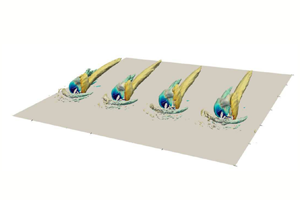Article contents
Influence of jet spacing in spanwise-inclined jet injection in supersonic crossflow
Published online by Cambridge University Press: 11 August 2022
Abstract

In separation control with air-jet vortex generators in supersonic flow, the spacing of the jets in a row array has a crucial effect on the control effectiveness. Previous experimental studies have revealed the overall influence of jet spacing on air-jet vortex generator controlled shock-induced separation zones, focusing mostly on the separation regions. There is, however, a gap in knowledge regarding the mechanisms leading to these changes in control effectiveness, particularly on the interaction between multiple jets and the details of downstream flow evolution. Therefore, the objective of the current study is to provide detailed information on the underlying flow dynamics associated with the injection of a row of spanwise-inclined jets into a supersonic turbulent boundary layer – and in particular the effects of different jet spacings. Four different spacings were studied with large-eddy simulations. In addition, we performed oil-flow and schlieren visualizations of separation control in a 24 $^\circ$ compression–ramp interaction with different jet-spacing configurations to validate and discuss our conclusions regarding the effects of jet/jet interactions on the separation-control effectiveness. We analyse the influence of jet spacing on the flow topology, induced vortical structures, and boundary-layer statistics. The jet-induced major vortex pair is the dominant flow structure energizing the near-wall boundary layer. The paper details how interactions amongst adjacent vortex pairs differ for varying jet spacings, thus influencing the momentum transfer and eventually the control efficiency. The dynamic behaviour of the flow was analysed using a three-dimensional dynamic mode decomposition. The resulting insights are key to the development of efficient control set-ups.
$^\circ$ compression–ramp interaction with different jet-spacing configurations to validate and discuss our conclusions regarding the effects of jet/jet interactions on the separation-control effectiveness. We analyse the influence of jet spacing on the flow topology, induced vortical structures, and boundary-layer statistics. The jet-induced major vortex pair is the dominant flow structure energizing the near-wall boundary layer. The paper details how interactions amongst adjacent vortex pairs differ for varying jet spacings, thus influencing the momentum transfer and eventually the control efficiency. The dynamic behaviour of the flow was analysed using a three-dimensional dynamic mode decomposition. The resulting insights are key to the development of efficient control set-ups.
JFM classification
- Type
- JFM Papers
- Information
- Copyright
- © The Author(s), 2022. Published by Cambridge University Press
References
REFERENCES
- 11
- Cited by





